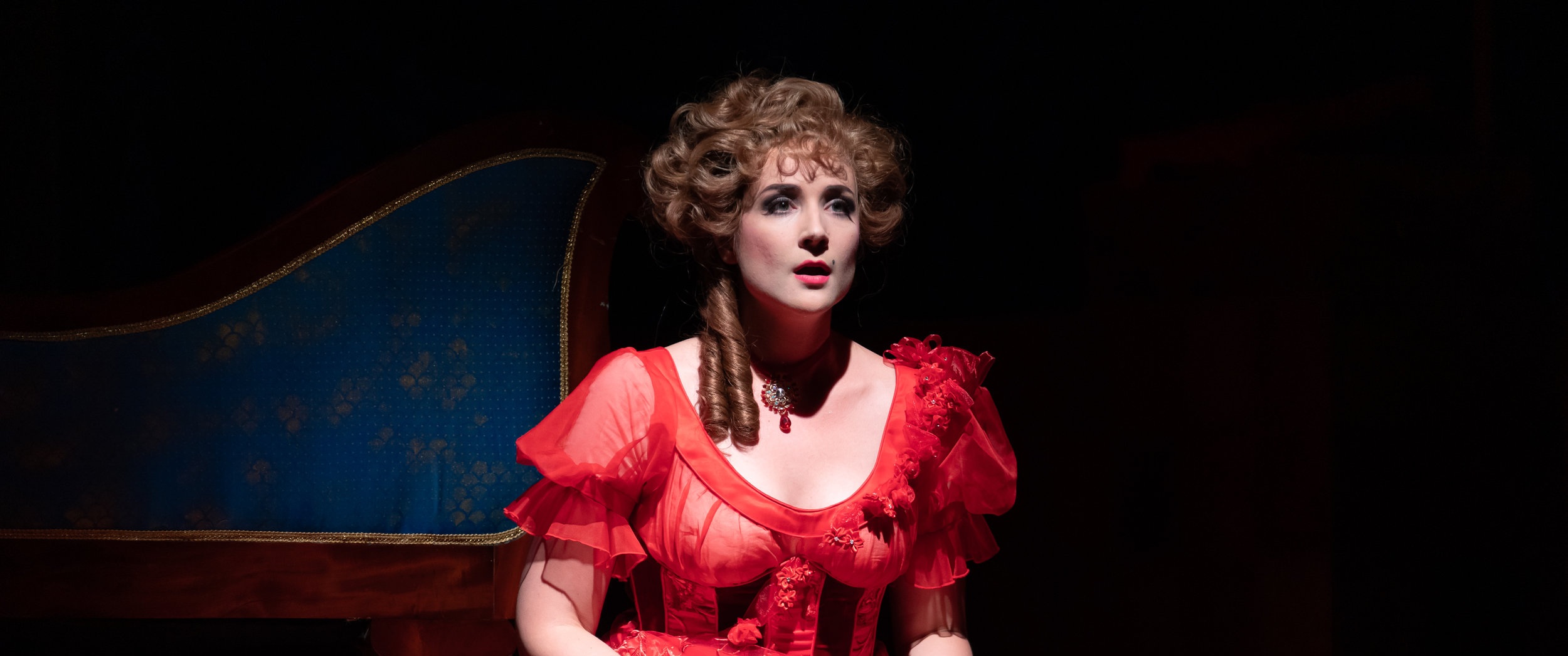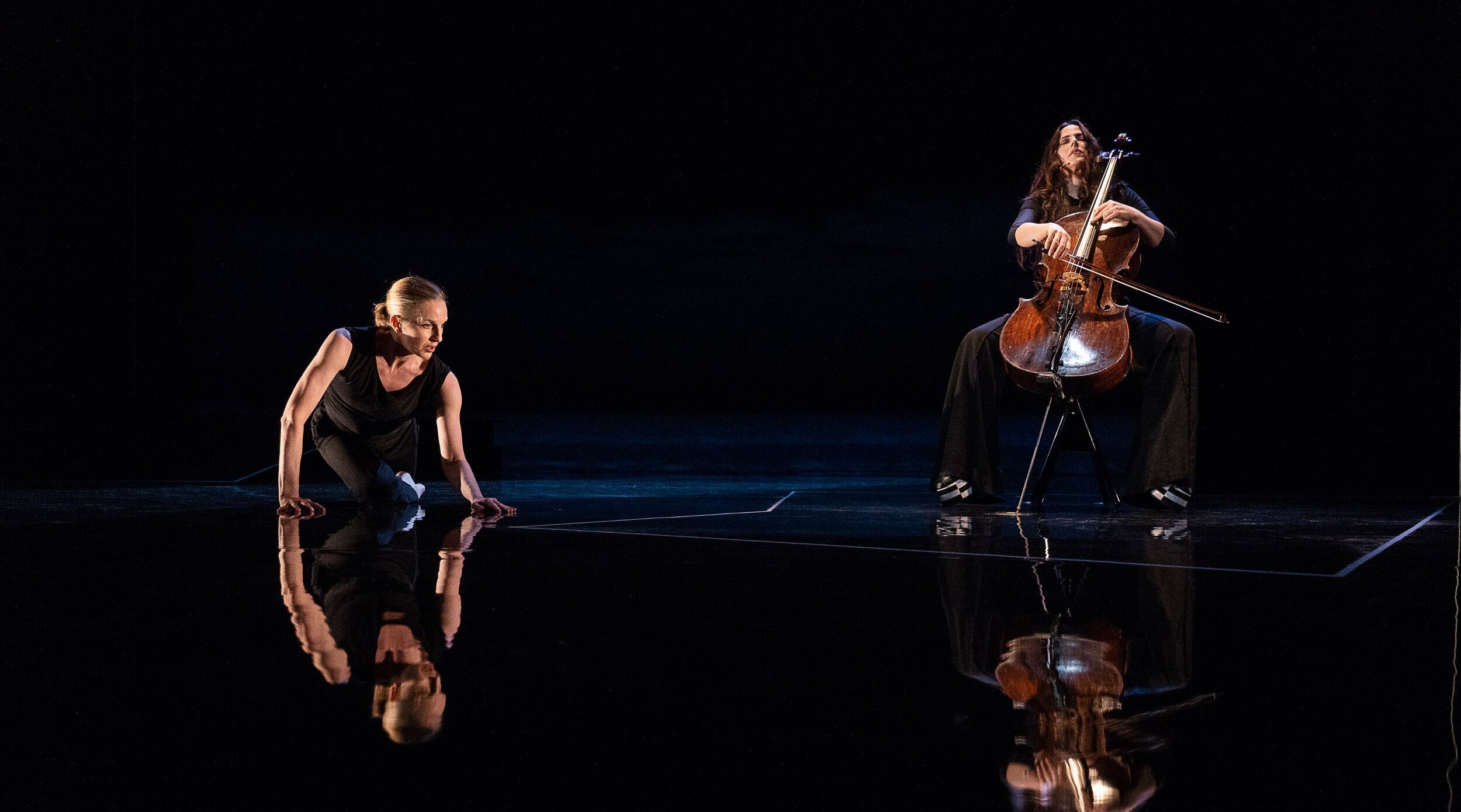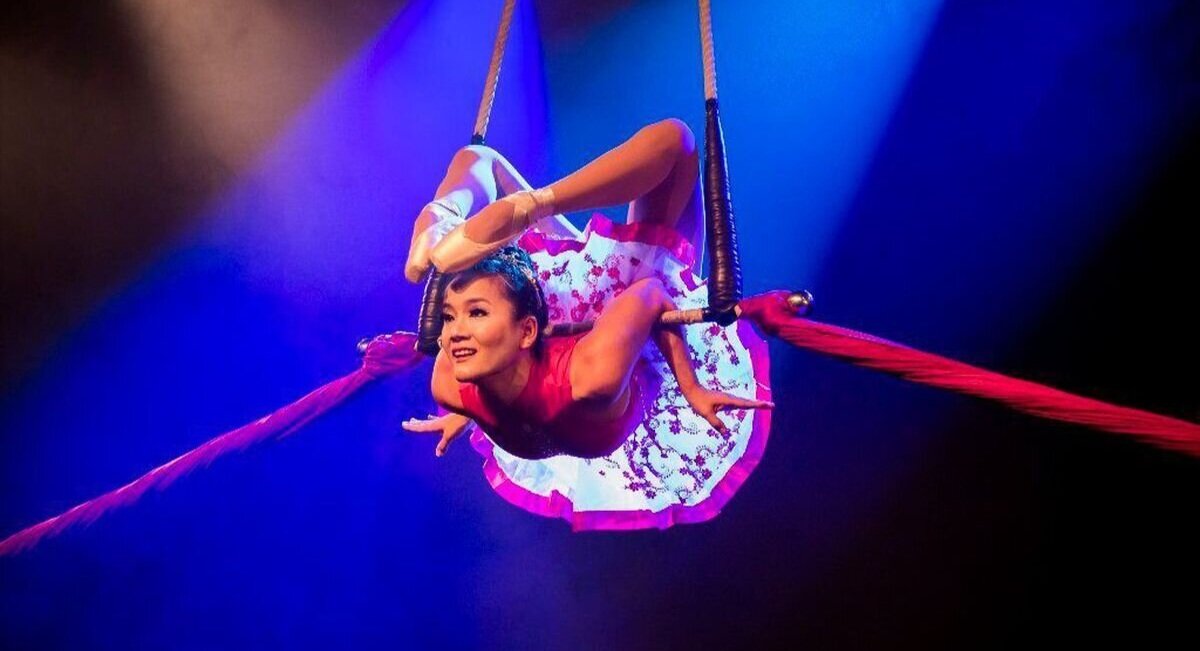Erasing Time

Erasing Time with Sara Shelton Mann
by Catherine Caraker
In the early nulls, when I returned to my hometown of San Francisco after 2 decades of living and dancing abroad, the sense of culture shock was exacerbated by entering a new dance community. I was initially puzzled by the odd mash-up of highly technical contemporary dance, circus skills and (often untrained) acting and singing that I encountered in many performances. It was not until I saw Sara Shelton Mann’s work that I began to understand the origins and context of this uniquely San Francisco cross-disciplinary performance aesthetic - and to feel that perhaps, after all, I was home again.
Kathleen Hermesdorf and Kim Epifano.
Sara is a gifted and visionary writer. From the first time I saw her work I was seduced by her mesmerizing use of the spoken word, recorded in her deep Southern drawl and often layered over Norman Rutherford’s stirring musical scores. Her text and musical scores at times are reminiscent of Robert Ashley’s "Private Parts" from his seminal 1979 opera created for television, Perfect Lives. Both share a moodily cinematic style of non-sequitur verbal imagery and new-age mysticism. Music, text, dance, video and set design share the stage as equal partners, reaching to express epic reflections on the plight of humanity and a society which seems hell-bent on its own destruction.
It’s impossible to put her work in a box. Choreographer, teacher, social activist, energy healer, deeply embodied investigator, she draws on many sources in her work and shares them generously with her collaborators and students. Her influence and legacy within the Bay Area dance community has been profound. Among the early members of her seminal company Contraband were Keith Hennessy, Kim Epifano, Jess Curtis, Nina Hart, Jules Beckman and Julie Kane, most of whom have gone on to become influential artists in their own right.
A few years ago Hennessy, one of Sara’s staunch advocates, organized a series of informal lectures at Kunst Stof Arts. During one evening when I was in attendance he showed videos of Sara’s work from the 80’s and 90’s. Sara was present, seated quietly at Keith's side as he shared stories and juicy tidbits about the history of Contraband. Their unusually collaborative process birthed fiercely experimental work integrating social activism with highly physical dancing, incorporating influences ranging from Contact Improvisation to circus arts, with live music, innovative set design, site-specific locations, experiential states, ritual, and much more included as fundamental elements.
For two nights last week, a 5-hour durational retrospective of Sara's work from the last 4 decades, entitled Sara Shelton Mann: Erasing Time, unfolded at YBCA. Working with David Szlasa and Norman Rutherford, the woman considered by many to be the high priestess of San Francisco dance theater live-directed several generations of dancers, including original members of Contraband.
Many of the archival videos Hennessy dusted off for the Kunst Stof lectures became a powerful element of last weekend’s Sara-thons. The films were projected on two screens suspended diagonally above the floor space of the YBCA Forum, sometimes positioned high above the performers and sometimes lowered to eye level. It must have been tough to choose which footage to use, but the selections proved to be essential to the whole experience (thanks to Szlasa, Sara’s work spanning 4+ decades has been digitized and can be now be watched here: https://vimeo.com/album/3349200). A standout moment for me came midway through the performance, watching a solo by Alia Swersky, 7 months pregnant and wearing a fitted red top as her powerfully viscous undulations and pensive stillnesses seemed to field echoes tossed across time from the often-frenzied action of the archival footage projected on the screens behind her.
The audience was invited to wander around, entering and exiting the space at will, but disappointingly few actually did so. As the show sold out both nights, people parked themselves and stayed put, and the crowds made it difficult to change one’s vantage point. In one corner, suspended from the ceiling by a chain, a huge block of ice containing a cherry blossom branch slowly dripped into large buckets set beneath it on the floor, replicating Lauren Elder’s ice sculpture from Contraband’s first full-length piece, Evol (1985). In another corner, typists created an ongoing soundscape, which at quieter moments would suddenly take on the suspense of a Hitchcock film. Along the back wall, Norman Rutherford headed a cast of live musicians, including veterans Jules Beckman and Peter Whitehead.
The furious pace of the evening at times felt relentless. Excerpt followed excerpt of full-on dancing, including reconstructed early choreographies performed in unison, more recent works from her “hybrid solo” series, and ensemble improvisations performed by generations of alumni. While there was rarely a moment to sit back and take a breath without fear of missing something, it was oddly satisfying to experience the juxtaposition of old and new, the reconstructed and spontaneously generated, even though, as my companion noted, at times it felt like a medley.
Some excerpts felt fresher than others. When the material shifted to more formal presentations of learned choreography, the performers’ shift in presence - the gaze out to the horizon, the perfect execution - at times felt at odds with the intended informality of the setting. What still felt timely were the distinct political and human aspects of the work - even captured on film, the early Contrabanders’ talking, singing, shaking, leaping and rolling in dirt contains a rawness that feels current to this day, while some of the beautifully reconstructed choreography felt like it belonged to another era.
Jess Curtis and Sara Shelton Mann.
Sara spent most of the performance on a chair in a corner of the space where she often spoke and was a constant witness to the performers. Having watched her dynamic process of live-directing on many occasions, during the first night I was struck by how laid-back she seemed, though I later learned she was confined to the chair because of a foot injury. On the second night she took no prisoners, pushing Christine Bonansea mercilessly in her hybrid solo with Jesse Hewitt. However, Christine gamely took up the challenge, laughing wildly and shrieking in French about “le mort” over Jesse’s supine body, eating up the space with her signature swoops and powerful leaps.
Known for collaborating with extraordinary performers and pushing them past their limits, Sara's collaborators are all accomplished artists in their own rights and the evenings were an embarrassment of riches, with talent on display from several generations of dancers. A few of the stand-outs for me were:
-- Anya Cloud and Leslie Seiters’ fascinating duet with ladders, from ever never animal and mud loves love, from one of Sara’s recent hybrid solo series. Anya’s writhing, punching, undulating and hopping on her knees as if battling an invisible opponent was riveting to watch.
-- Marintha Tewksbury’s electrifying solo in a red dress, all lithe gorgeousness and vibrating presence in space.
-- Kathleen Hermesdorf, a long-time collaborator and fierce proponent of Sara’s work was on fire, dancing Sara’s reconstructed choreography as if it were created yesterday.
-- Keith Hennessy in a long pink dress cracking a bullwhip with obvious relish, asking us, “Do you want to be spanked?” while Norman Rutherford wailed desperately on a sax, in a duet from Mira 1 (1990), and later in a monologue, acknowledging that we were in an arts space that was built on the destruction of an affordable housing complex - a timely reminder that our current housing crisis has been a long time in the making.
-- Alia Swersky and Abby Crain's simultaneous wow-inducing balancing acts on chairs, involving oranges and persimmons -- throughout the evenings Crain electrified, a fluid hurricane, fast, soft and furious, eating up the space.
-- Jules Beckman, a sort of Pan figure with a banjo instead of a flute, in a dress with a long feathery tail hanging below the hem, sang and played a heartbreakingly beautiful song called "Lonely Boy." Later he dangerously hurled a box on wheels with a child riding on it, back and forth across the space, catching it just before it crashed into the audience seated on the floor.
-- The beautiful simplicity of 4 original Contraband dancers, 2 with blindfolds, doing a partnering score involving the blinded person following touch impulses into open space.
-- Rajendra Serber and Abby Crain running full-tilt at each other and then falling into each others’ arms, stopping cold in a spiral counterbalance in the center of the space, felt like they were holding up the whole room for a few magical moments. The audience cheered.
-- Cameo appearances on both nights by toddlers who entered the improvisations and were generously incorporated by the performers.
Marintha Tewksbury.
It was fantastic to see so many mature performers from the Contraband days come back and absolutely kick ass, busting stereotypes about aging in the dance field. Julie Kane, in particular, surprised and delighted with her gorgeously embodied presence after many years out of the scene, and Kim Epifano, indomitable, dances with a passionate athleticism which defies time.
For the final free-for-all, there were probably a good 50 dancers hurling themselves about the space, the ensemble bulked out by many of Sara’s enthusiastic students. This score kept ending and then repeating again, to the point where my attention truly was exhausted and I had to admit that I’d much rather be doing this than watching it. After the performance ended, the nearly complete lack of people of color in this show, despite the large number of performers, made for interesting conversation on the politics and economics of the contemporary dance field.
At 70, Sara Shelton Mann shows few signs of slowing down. Her directorial and teaching style can be challenging for the uninitiated. She yells, contradicts herself, gestures wildly, jumps around and makes it very clear when she’s not getting what she wants. Underneath it all runs a sweet stream of compassion, humor and great perceptiveness. She channels an energy that sometimes seems too big for her fragile body. A force of nature, she is a compassionate warrior advocating for the future of our humanity and the planet, and it’s heart-warming to see her finally receiving the recognition she deserves for her decades of inspiring and generous work.
Header photo: Sara Shelton Mann, Norman Rutherford, Keith Hennessy. All photos by Robbie Sweeny Photography.
View more of Robbie Sweeny's exceptional photography from both nights of ErasingTime.
If you liked this, like A Beast on Facebook for more.
Catherine Caraker is a dance artist, performer and teacher who also likes to write. A native of San Francisco, she has spent her adult life living between the US and Europe. She is passionate about movement and live performance, both watching and doing.










